School Design That Gets Inside a Student's Head
- By Michael Fickes
- 04/01/14
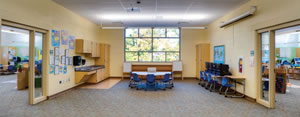
PHOTOS COURTESY OF KI
For years now, school design professionals have been saying that interior school design affects student performance. Some say research, however, has failed to support the idea. True, studies have shown that certain elements of interior design improve performance. Many studies, for instance, say that natural daylight boosts academic performance. As a result, architects now routinely provide for natural lighting in schools.
But what about the learning environment as a whole? Do classroom space designs, colors, furnishings, technology and other classroom features affect student performance?
Yes, say architects, teachers and administrators.
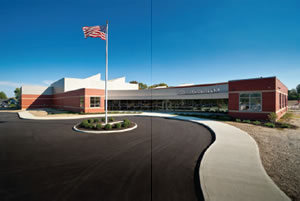
PHOTOS COURTESY OF KI
Prove it.
Researchers in the School of the Built Environment at the University of Salford in Manchester, England, have completed and published a peer-reviewed pilot study in “Building and the Environment” that does quantify the effects of school environment on students in elementary grades.
Researchers followed 751 students over the course of a school year. They began by collecting data describing each student’s age, gender and level of achievement in math, reading and writing. Next, researchers tied one of 34 different classroom environments in seven different schools to each student, recording design elements, including the basics such as lighting, air quality, flexibility and storage space.
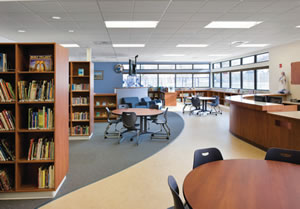
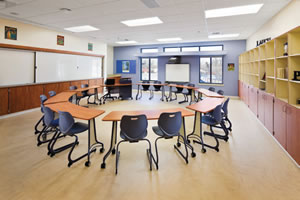
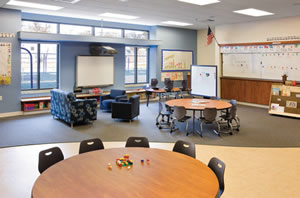
PHOTOS COURTESY OF KI
Talking in School. The idea is to allow students to work collaboratively. Specialized classrooms have desks, but the configuration is quite different from traditional classrooms. Some have tables or long desks with multiple stations parallel each other allowing students to sit face-to-face, a set up that encourages talking. St. Anthony Tri-Parish Schools, in Casper, Wyo., features large, open, colorful classrooms with round tables and soft seating. Different classrooms use tables shaped to facilitate the kind of collaboration called for by the subject being taught.
The difficult part of this kind of research is that many factors affect academic performance. Illness, trouble at home, the quality of teachers and countless others come into play. To measure these other factors, the researchers created a model that accounted for “the variability in the learning improvements of the pupils, over the course of a year.”
In analyzing the observed changes, researchers concluded that nearly three-quarters — 73 percent — of the observed differences in performance arose in the classroom and “linked entirely to six built-environment design parameters, namely: color, choice, connection, complexity, flexibility and light.”
In other words, the classroom affects students in many different ways, including their academic performance. When the researchers evaluated academic performance student by student, they concluded that classroom design contributed as much as 25 percent to the progress made by a student over the course of the year. Good environments enabled positive progress, with poor environments generally ensuring negative progress.
Professor Peter Barrett, School of the Built Environment, the lead author of the research paper produced by the study says: “It has long been known that various aspects of the built environment impact on people in buildings, but this is the first time a holistic assessment has been made that successfully links the overall impact directly to learning rates in schools. The impact identified is in fact greater than we imagined, and the Salford team is looking forward to building on these clear results.”
The study will continue through the current school year. The research team will compare the results of this school year with those gathered during the last school year. Not everyone agrees with the conclusions of the Salford study. In the U.K. where the study was carried out, for instance, an architectural magazine called Dezeen has reported that a spokesperson offering the government’s response to the study said: “There is no convincing evidence that spending enormous sums of money on school buildings leads to increased attainment. An excellent curriculum, great leadership and inspirational teaching are the keys to driving up standards.”
Despite the U.K.’s government spokesperson, architects and vendors now point to the Salford study to support the development of a new kind of learning environment.
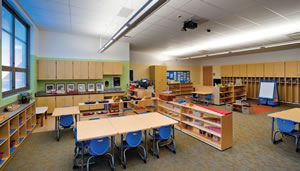
PHOTOS COURTESY OF KI
“I agree with the British government spokesperson that inspirational teaching is important,” says Amy Kiefer, vice president, Education Markets with KI, a Green Bay, Wis.-based manufacturer of school furniture. “But there are three components to quality education. In addition to pedagogy, the learning styles of students are important. The environment is the third component. Each of these components combined facilitate learning.”
Teaching and learning styles
Today’s flipped teaching styles often deliver lectures and presentations to students at home in the evening through technology. During the day, in class, students collaborate on group assignments seated around tables, sharing materials and thoughts with each other. The teacher works with each group in turn, making sure that everyone understands the concepts.
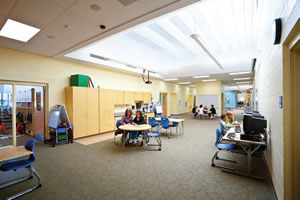
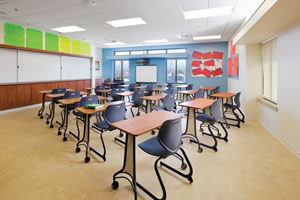
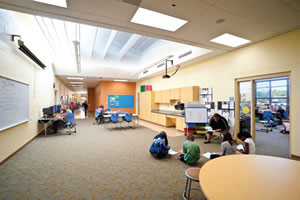
PHOTOS COURTESY OF KI
Keep It Flexible. Space design in schools should reflect and support the faculty’s pedagogical philosophies and learning styles. For example, Sands Montessori School, in Cincinnati, Ohio, uses furniture to break up large, open classrooms into smaller areas for several working groups.
Such teaching styles fit the learning styles of today’s generation of students, who are dramatically different from their predecessors. According to a study conducted by the Pew Research Center during 2010, the teens and twenty-somethings of the Millennial Generation are “confident, open to change, team-oriented, self-expressive, upbeat and more ethnically and racially diverse.”
The Millennial Generation is also a digital generation. According to the Pew study, 71 percent of teens aged 12 to 17 own cell phones. Eighty percent of teens that own cell phones sleep with their phones. Thirty-eight percent send text messages daily. Ninety-three percent go online.
These non-traditional students need new kinds of learning environments. The traditional ones don’t work for them.
How does this change space design?
Space design in schools should reflect and support the faculty’s pedagogical philosophies and the various learning styles, writes Kiefer in a white paper entitled “Learning Per Square Foot: Shifting the Education Paradigm.”
In the paper, Kiefer notes that space design has not kept pace with today’s emerging teaching and learning styles.
Traditional classroom designs fit students into rooms behind rows of desks that promote individual study, a style of learning that doesn’t fit today’s active, collaborative learners. Nor does it fit flipped classrooms and other emerging pedagogical styles.
Kiefer’s white paper calls for the adoption of entirely new educational space design principles — “principles that leave behind the familiar practice of designing space by headcounts, initiatives that instead reflect the trend to more studentcentered collaborative and group learning, with a focus on space effectiveness rather than just greater capacity and throughput and that foster learning via community.”
Consider the Pan American Academy Charter School in Philadelphia, Pa. It serves disadvantaged K-8 students from come to us two-to three years behind in their reading levels,” says Wanda Novales, Pan American Academy’s CEO. “If we don’t work twice as hard now, the future may not be as bright as we want it to be for our students.”
Overcoming disadvantages makes learning per square foot an important concept here. In the corridors, for instance, study nooks furnished with tables call out to students. Set at café height, the furniture puts seated students at the same height as those passing by and encourages conversation.
The corridors as well as the classrooms aren’t all work, though. The walls and floors feature bright colors — reds, blues, greens, yellows, you name it. “No matter what door you come through, you are greeted by bright colors,” says Principal Darcy Russotto. “The first thing people say is ‘Wow, how colorful.’”
Most of the classrooms have tables and chairs instead of rows of individual desks, but they are not the same tables and chairs. Some classrooms have rectangular tables with beige tops. Others have round tables with lime green tops.
Some have tables. Shaped like triangles with rounded corners, they fit together like puzzle pieces to create larger conference tables for larger groups of students.
The chairs come in many colors: orange, blue, green.
“I’ve been in many different schools with an industrial feel,” says Julius Rivera, a special education kindergarten teacher at Pan American Academy. “The furniture here is simple but also elegant, colorful and durable. And we can move it around for different activities. It fosters group work and interactions.”
Specialized classrooms, like the computer lab, do have desks, but the configuration is quite different from traditional classrooms. Here, two long desks with multiple stations parallel each other allowing students to sit face to face, a set up that encourages talking and collaboration. No traditional shushing at this school. Of course, the teachers must work to keep the conversations on point.
Kids like going to school at the Pan American Academy. The school was founded in 2008 and attracted 270 students. Today, there are 730 students. In the last year alone, 250 new students signed in.
“We have a lot fewer students absent,” says Russotto. “We have a lot fewer students that are late, and we’re maintaining a 98-percent attendance rate, pretty much every day. I think that has a lot to do with the students being comfortable in the environment here.”
A problem with all of this, of course, is that this kind of interior design and furnishing carries a cost premium that many communities may be unwilling to pay.
Still, as the Salford study indicates and as the Pan American Academy seems to prove: flexible and open interior school design, combined with colors and packed with lots of learning per square foot can improve student performance. Isn’t that worth the price?
This article originally appeared in the issue of .